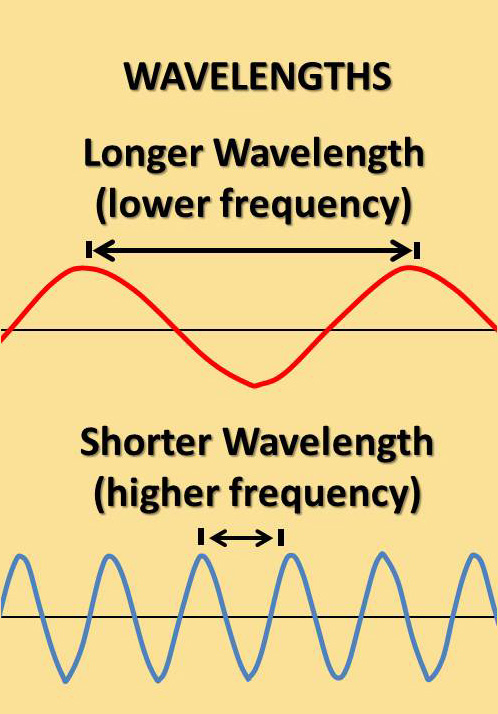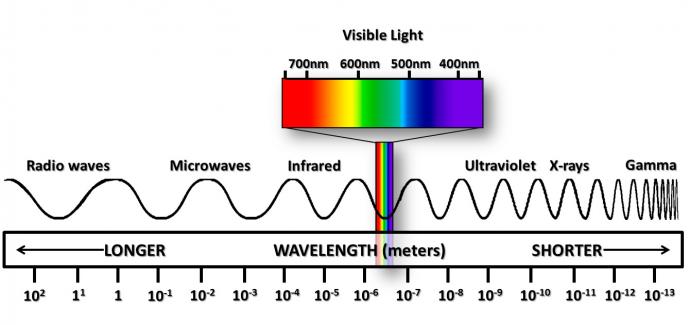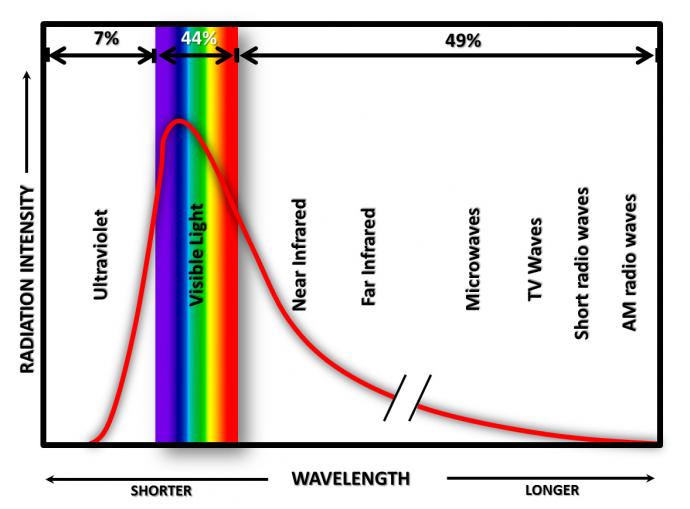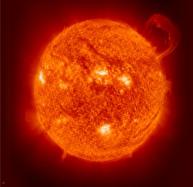Electromagnetic Radiation
Radiation from the Sun
Almost all of the energy available at Earth’s surface comes from the sun. The sun gets its energy from the process of nuclear fusion. This process occurs in the sun’s core or interior, where temperature and pressure are extremely high. During most of the sun’s life, energy comes from the fusion of hydrogen nuclei. In this process (explained simply), four hydrogen nuclei are fused, forming a helium nucleus. Energy is released because the helium nucleus has a slightly lower mass than the four original hydrogen nuclei. Einstein’s famous formula (E = mc2 or Energy = mass × the speed of light squared) explains why energy is released. This energy eventually makes its way to the outer regions of the sun and is radiated or emitted away in the form of energy, known as electromagnetic radiation. A particle of electromagnetic radiation is known as a photon. Electromagnetic radiation, also known as radiant energy (or radiation), is spread in the form of electromagnetic waves.

Electromagnetic Waves
Electromagnetic waves are waves that can cause charged particles (such as electrons) to move up and down. These waves have both electrical and magnetic properties and can travel through gases, liquids, solids, and through empty space (or a vacuum) at nearly 300,000 kilometers per second (the speed of light).
Electromagnetic waves are characterized by wavelength and frequency. The wavelength is the distance between two wave crests or troughs. The highest point of a wave is called the crest, and the lowest point of a wave is called the trough. Frequency is expressed in hertz (Hz) and refers to the number of wavelengths that pass a fixed point in 1 second. The shorter the wavelength is, the higher its frequency will be. The reverse is also true. For example, radio waves have the longest wavelength and the lowest frequency.
Electromagnetic Spectrum
The electromagnetic spectrum represents the complete range of electromagnetic radiation. The region of the spectrum with a shorter wavelength than the color violet is referred as ultraviolet radiation, and the region of the spectrum with a longer wavelength than the color red is referred to as infrared radiation.

| Prefix/Symbol | Meaning | Multiplier | |
|---|---|---|---|
| giga (G) | One billion | 109 | 1,000,000,000 |
| mega (M) | One million | 106 | 1,000,000 |
| kilo (k) | One thousand | 103 | 1,000 |
| hector (h) | One hundred | 102 | 100 |
| deca (da) | Ten | 10 | 101 |
| deci (d) | One-tenth | 10-1 | 0.1 |
| centi (c) | One-hundredth | 10-2 | 0.01 |
| milli (m) | One-thousandth | 10-3 | 0.001 |
| micro (μ) | One-millionth | 10-6 | 0.000001 |
| nano (n) | One-billionth | 10-9 | 0.000000001 |
The Sun’s Electromagnetic Spectrum
The energy that reaches the Earth is known as solar radiation. Although the sun emits radiation at all wavelengths, approximately 44% falls within visible-light wavelengths. The region of the spectrum referred to as visible light (light our eyes can detect) is composed of
relatively short wavelengths in the range 400 nanometers (nm), or 0.4 micrometers (μm), through 700 nm, or 0.7 μm.



